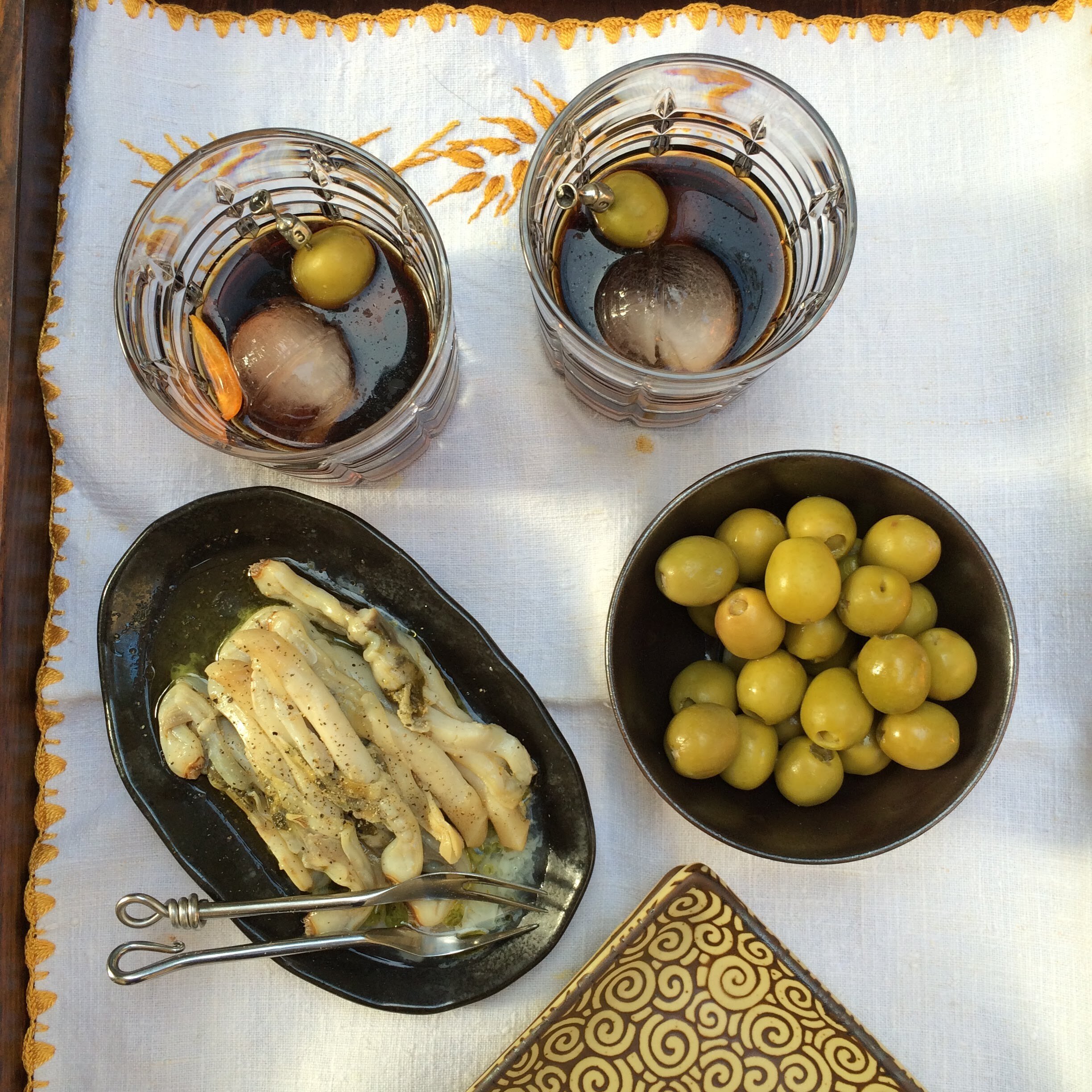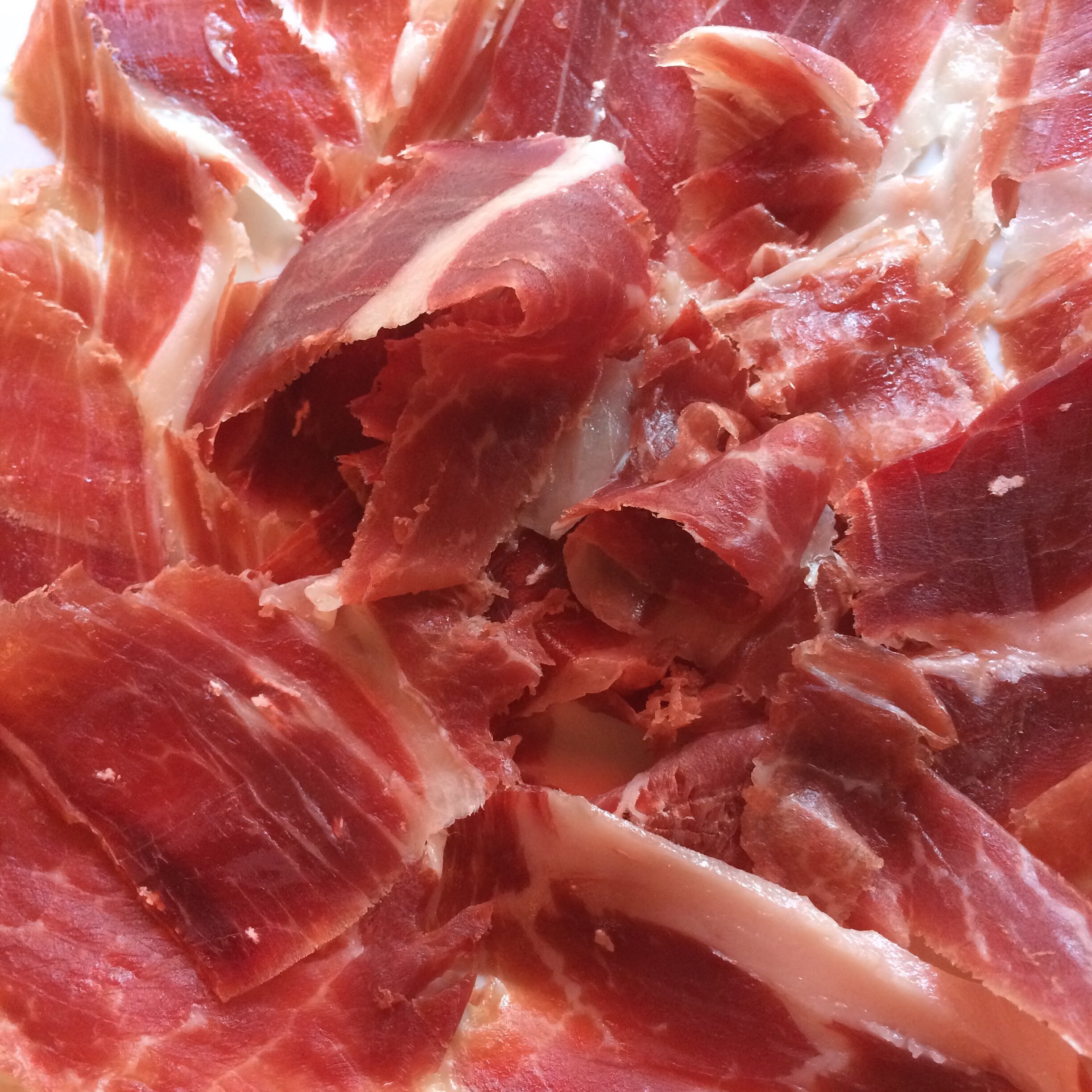Where to get the most authentic stuff | BARCELONA
Your Shopping Guide for a true taste of Barcelona
Succulent cured tuna loin: mojama de atún
You might be able to find everything you need for the Barcelona dinner party in your local stores, depending where you live and how strictly authentic you want to be. But just in case, here are some online shopping links. I’m assuming you’re in the U.S. for purposes of this advice.
(Full disclosure: As an Amazon Associate, I may earn a commission — at no additional expense to you — from qualifying purchases made through the Amazon links.)
La Tienda, The Spanish Table, Donostia Foods, and Yummy Bazaar carry a wide variety of authentic Spanish food products, including many of the ones listed below.
Clockwise from top: vermut cocktails, anchovy-stuffed olives, razor clams from a can of conserva.
SPANISH VERMUT
I highly recommend the brand Casa Mariol Vermut Negre, which comes in a 1L bottle for just over $20. You can usually find it at K & L Wines’ excellent online shop, here. Astor Wines & Spirits in New York City also has it in stock right now, here.
ANCHOVY-STUFFED OLIVES
The Peregrino brand (a creation of La Tienda) is my go-to for anchovy-stuffed green olives. You can find Peregrino from Amazon via La Tienda’s storefront there, or from La Tienda directly. I also like Ybarra from The Spanish Table. Donostia Foods also carries an excellent proprietary version using Manzanilla olives.
The Reese brand has placed its anchovy-stuffed manzanilla olives in many online and brick-and-mortar stores, but in my opinion, they’re not great. Better than nothing, but not great.
CONSERVAS
The Matiz and Ortiz brands, which do several different types of seafood conservas, are available online in the U.S. from many online retailers. They’re solid ones to look for.
People differ on which type of tinned seafood they prefer, but cockles – berberechos in Spanish – are one of my favorites. They’re small, tender, sweet and a bit out of the ordinary for North Americans. You can find cockles from Amazon, from Walmart, and from Donostia Foods.
While not traditionally Catalan, smoked baby clams are a delicious, inexpensive option to consider. (But beware of your local grocery store’s mainstream brands, which I’ve found to be sandy and gross.) I am a loyal purchaser of Crown Prince Natural smoked baby clams in olive oil from Trader Joe’s (the cheapest source), but Walmart and some other big grocery or big-box stores also carry them.
Other preserved seafood I recommend is tinned octopus (though this can be too fishy for some people), sardinillas (small sardines), mussels, and boquerones – the vinegar cured (so, still almost white in color) anchovy fillets that have been popping up more and more in American restaurants lately. Donostia Foods carries a great selection, at very fair prices.
JAMÓN
The best ham in the world, IMHO, is jamón ibérico de bellota. It’s made from the Iberico breed of pig that’s fattened up on acorns (bellotas) that the pigs forage freely in the oak forests of rural Spain. If you don’t want to spring for the classic hind-leg ibérico de bellota ham at $220+ per pound ($13+ per ounce), try the front-leg hams – paleta (pah-LAY-tah) – from the same animal, which are a bit cheaper.
The next price point down is jamón ibérico, which didn’t get the acorns (or the outrageous marbling), but is still the same kind of pig and the same kind of flavor. For an even lower-cost option, look for jamón serrano (ha-MOAN say-RONN-no). It’s a different breed of pigs with different feed, much less marbling, and far less aging time, but it’s still tasty and less than $25 per pound/$1.50 per ounce. You could also just swap in some good prosciutto from your local store and call it a day . . . but promise me someday you will taste the bellota.
You could also consider swapping in Catalan fuet or Spanish dry-cured chorizo (NOT Mexican chorizo, which is totally different). These are both absolutely delicious cured salami-type charcuterie – highly seasoned, rich and satisfying – and a fraction of the price of true bellota. If you’ve got a good source for French-style saucisson sec, that’s a good substitute for fuet. France is right over the border from Catalonia, after all.
The U.S. has very strict rules about importing Spanish ham, so only a few brands are widely available here. The easiest one to find is called Fermín, and it’s available from Spanish Table, La Tienda, and of course Amazon. Cinco Jotas is also available at several stores. You only need a little ham to get a taste, but you will want more. These places also carry the cheaper jamóns and dry Spanish chorizo.
If you’re not a ham/pork eater, grab some cured tuna loin – mojama de atún (mo-HOMM-ma day ah-TOON) – instead and serve it the same way. La Tienda has it for around $24, and Dona Maria Gourmet sells a seven-ounce block for $40 (Amazon carries that same product). Note that this is a cured product, and it generally doesn’t need to be refrigerated until you open it. Once open, it keeps wrapped in plastic in the fridge for up to 6 months, so if you don’t need it all for the party, no worries! Enjoy it the next day in place of lox on your bagel, or just flaked over a salad.
SAUSAGE (BOTIFARRA)
The classic botifarra sausage is very light colored – practically white – and mild in its seasoning, but deeply savory and tender. You can usually find botifarra/butifarra/butifarrita (try all spellings) online at Spanish Table, Delicias de España, and a few other places for about $10/pound.
People in the San Francisco Bay Area can also now buy fresh, local butifarra sausages from Encina Farms! These guys raise free-range Iberico breed pigs in certified organic pastures and oak forests in Lake County, and sell their products online, at the Napa Farmers Market, and a few other select retailers. (More info on them here.)
DRIED ANCHO CHILIES
Richly flavored chilies are the key to a delicious romesco sauce. In Spain, they are more likely to use ñora chilies, but anchos are a totally worthy, inexpensive, easy-to-find substitute in the US. You can find them at virtually every Mexican grocery, or (of course) online on Amazon. In the San Francisco Bay Area, you can also find them at mainstream grocery stores like Raley’s, Lucky’s, and Safeway.
SPANISH PIMENTÓN de la VERA
This amazing smoky paprika is only a distant cousin to the Hungarian version most Americans are familiar with. Pimentón de la vera has an incomparable aroma and depth of flavor thanks to the time the peppers spend in the oakwood smoke before being ground. Accept no substitutes!
It comes in three levels of spiciness – the one you want for this menu is the spicy one, picante. Unless you don’t like spicy food, in which case get the mild one, dulce. One tin will last for years (unless you become addicted and start putting it on everything, which may happen).
La Dalia is a good brand to look for. It’s usually available online via Amazon, as well as in the usual Spanish food stores.
PORRÓ
This alternative wine-drinking vessel is a lot of fun . . . if you dare to give it a shot. (My recommendation is to dress in black and practice with water until you’ve got the hang of it.) You can always use it as a serving pitcher, if the traditional method isn’t working for you. The Spanish name for a porró is porrón, and you can find one online directly from La Tienda or at their Amazon storefront.
Having trouble finding something else mentioned in the book? Or, have you found a better source than the ones listed above? Let me know! This post is a living document, and I’ll update it as needed.


